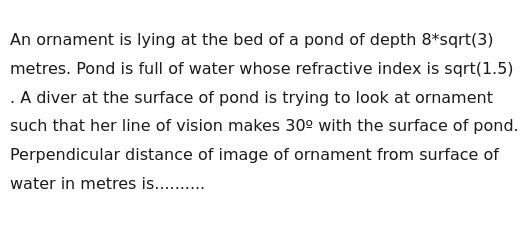Question
Question: An ornament is lying at the bed of a pond of depth 8*sqrt(3) metres. Pond is full of water whose re...
An ornament is lying at the bed of a pond of depth 8*sqrt(3) metres. Pond is full of water whose refractive index is sqrt(1.5) . A diver at the surface of pond is trying to look at ornament such that her line of vision makes 30º with the surface of pond. Perpendicular distance of image of ornament from surface of water in metres is..........

8
Solution
Let h be the real depth of the ornament, which is h=83 m.
The refractive index of water is μ=1.5=3/2.
The diver is at the surface and her line of vision makes an angle of 30∘ with the surface. This is the angle of refraction in air (θ1) measured from the surface. The angle of refraction with the normal is θ1′=90∘−30∘=60∘.
Let θ2 be the angle of incidence in water, measured with the normal. According to Snell's Law, μwatersin(θ2)=μairsin(θ1′). Assuming μair=1, we have 3/2sin(θ2)=1⋅sin(60∘). 3/2sin(θ2)=23. sin(θ2)=3/23/2=23⋅32=22=21. This gives θ2=45∘.
Let O be the position of the ornament at the bottom, and B be the point on the surface directly above O. So, OB = h. Let C be the point on the surface where the ray from O strikes and refracts towards the diver's eye A. In the right-angled triangle OBC, the angle of incidence is ∠OCB=θ2=45∘. The horizontal distance BC is given by BC=OBtan(θ2)=htan(θ2). BC=(83)tan(45∘)=83⋅1=83 m.
The image I of the ornament is formed at the point where the refracted ray CA, when extended backward, appears to intersect the vertical line OB. The perpendicular distance of the image from the surface is the apparent depth, let's call it h′. In the coordinate system where B is the origin (0,0), the surface is the x-axis, and the vertical line OB is the y-axis. O is at (0, -h). C is at (BC, 0) = (83,0). The refracted ray CA makes an angle θ1′=60∘ with the normal (y-axis). The angle the line CA makes with the positive x-axis is 90∘+θ1′=90∘+60∘=150∘. The slope of the line CA is m=tan(150∘)=tan(180∘−30∘)=−tan(30∘)=−1/3. The equation of the line CA passing through C(83,0) is y−0=m(x−83). y=−31(x−83).
The image I is on the y-axis, so its x-coordinate is 0. Let its y-coordinate be −h′. Substitute x=0 and y=−h′ into the equation of the line CA: −h′=−31(0−83)=−31(−83)=8. So, −h′=8, which means h′=−8. The negative sign indicates that the image is below the surface, which is expected. The perpendicular distance from the surface is the absolute value, h′=8 m.
Alternatively, using the formula for apparent depth viewed at an angle: h′=htan(θ1′)tan(θ2). h=83 m. θ2=45∘, tan(θ2)=1. θ1′=60∘, tan(θ1′)=3. h′=(83)31=8 m.
The perpendicular distance of the image of the ornament from the surface of water is 8 metres.
